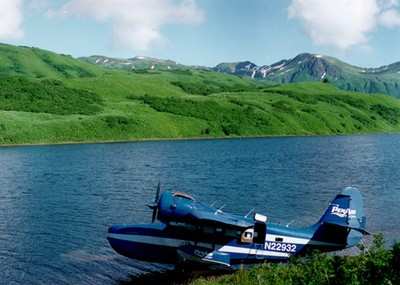Airplane Was Being Repositioned For The Summer, Weather A Concern
The NTSB has released a preliminary report from an accident involving a Grumman G-21A Goose that went down in the mountains of Montana. The pilot of the aircraft was fatally injured in the accident.

According to the report, on June 17, 2014 about 1700 mountain daylight time, a Grumman G-21A airplane, N888GG, was destroyed by impact with terrain and a postcrash fire in the parking lot of the Lost Trail Powder Mountain Ski Area, about 13 miles south of Sula, Montana. The airplane was being operated by the pilot as a visual flight rules (VFR) cross-country positioning flight under 14 Code of Federal Regulation Part 91. Instrument meteorological conditions (IFR) were reported in the area at the time of the accident, and the solo pilot received fatal injuries. The airplane departed Lemhi County Airport (KSMN), Salmon, Idaho, bound for Ravalli County Airport, Hamilton, Montana, about 1640.
During an interview with the NTSB investigator-in-charge (IIC) on June 18, the owner of the airplane said that the airplane was being repositioned to the Ravalli County Airport for the summer. The airplane arrived at the Dillon Airport (KDLN), Dillon Montana on Monday, June 16, but was unable to continue to Hamilton due to weather. The owner said the pilot was told to remain in Dillon until the weather cleared. The pilot told the owner that he might fly to Salmon the following morning and check the weather along the highway to Hamilton. The owner asked the pilot to telephone him before he departed. The owner said he did not receive a telephone call from the pilot.
During a telephone conversation with the NTSB IIC on June 18, a witness at the Dillon Airport said he had spoken with the pilot after he arrived in Dillon. They talked about weather and routes. The witness said the following morning the airplane departed about 0830, but returned a short time later due to weather. He said the airplane remained in Dillon the rest of the day, and about 1630 the pilot said he'd probably be back in 30 minutes, and departed. The witness did not see the airplane again.
A Ravalli County Sheriff's representative told the IIC that he had spoken to a witness at the Lemhi County Airport who told him the airplane had stopped there, before departing northbound along highway 93 toward Hamilton.

A witness living along highway 93, about the 4,000 foot elevation level, said he had seen the airplane northbound headed toward the mountain pass in the direction of Hamilton. The witness is a pilot and said he had flown the route many times. He said although the airplane was in VFR conditions, and appeared to be at an altitude of about 6,500 feet when he saw it; the pass is higher, and appeared to be obscured. He further stated he could see what he thought was a thunderstorm developing to the west and moving east toward the pass.
The highway 93 mountain pass is just over 7,000 feet in elevation. Located at the summit are a visitor center and the base of operations for a ski area; including a lodge and parking lot.
An employee at the visitor center told the Sheriff's representative that the airplane arrived over her position at a very low altitude, just above the trees, and that it was snowing, and the visibility was about ¼ mile at the time. She said she saw the airplane "spin around" 6 to 7 times descending vertically before it impacted the ground in the parking lot of the ski area.
Upon impact, the airplane burst into flames, initial responders were not able to approach the wreckage due to the intense heat and flame.
On June 18, the airplane was examined at the accident site by the NTSB IIC, accompanied by an FAA air safety inspector.
(Image from file. Not accident airplane)
 ANN's Daily Aero-Term (04.24.24): Runway Lead-in Light System
ANN's Daily Aero-Term (04.24.24): Runway Lead-in Light System ANN's Daily Aero-Linx (04.24.24)
ANN's Daily Aero-Linx (04.24.24) Aero-FAQ: Dave Juwel's Aviation Marketing Stories -- ITBOA BNITBOB
Aero-FAQ: Dave Juwel's Aviation Marketing Stories -- ITBOA BNITBOB Classic Aero-TV: Best Seat in The House -- 'Inside' The AeroShell Aerobatic Team
Classic Aero-TV: Best Seat in The House -- 'Inside' The AeroShell Aerobatic Team Airborne Affordable Flyers 04.18.24: CarbonCub UL, Fisher, Affordable Flyer Expo
Airborne Affordable Flyers 04.18.24: CarbonCub UL, Fisher, Affordable Flyer Expo




